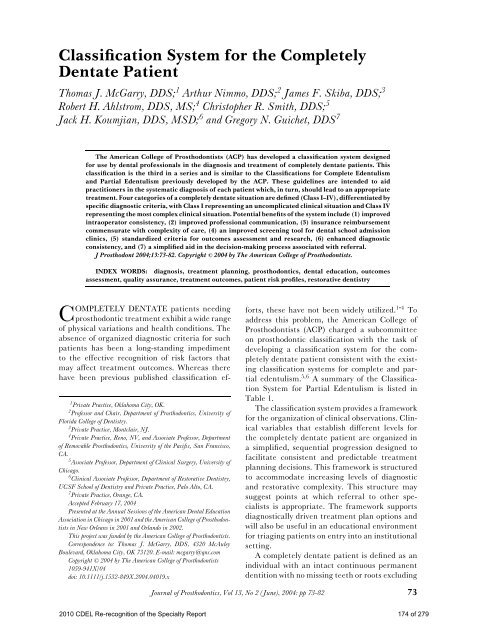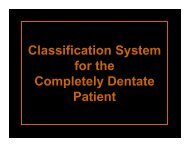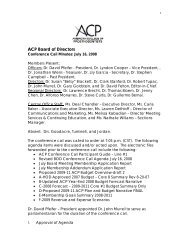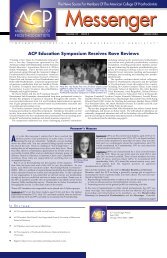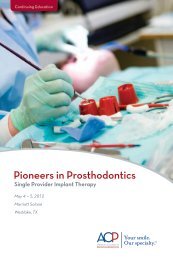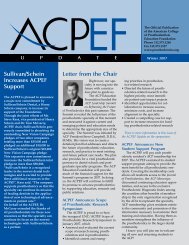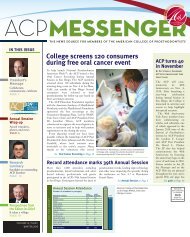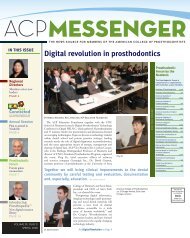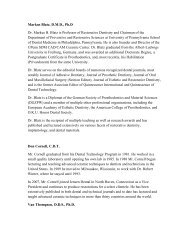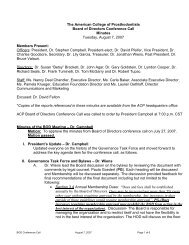PROSTHODONTICS - American College of Prosthodontists
PROSTHODONTICS - American College of Prosthodontists
PROSTHODONTICS - American College of Prosthodontists
You also want an ePaper? Increase the reach of your titles
YUMPU automatically turns print PDFs into web optimized ePapers that Google loves.
Classification System for the CompletelyDentate PatientThomas J. McGarry, DDS; 1 Arthur Nimmo, DDS; 2 James F. Skiba, DDS; 3Robert H. Ahlstrom, DDS, MS; 4 Christopher R. Smith, DDS; 5Jack H. Koumjian, DDS, MSD; 6 and Gregory N. Guichet, DDS 7The <strong>American</strong> <strong>College</strong> <strong>of</strong> <strong>Prosthodontists</strong> (ACP) has developed a classification system designedfor use by dental pr<strong>of</strong>essionals in the diagnosis and treatment <strong>of</strong> completely dentate patients. Thisclassification is the third in a series and is similar to the Classifications for Complete Edentulismand Partial Edentulism previously developed by the ACP. These guidelines are intended to aidpractitioners in the systematic diagnosis <strong>of</strong> each patient which, in turn, should lead to an appropriatetreatment. Four categories <strong>of</strong> a completely dentate situation are defined (Class I–IV), differentiated byspecific diagnostic criteria, with Class I representing an uncomplicated clinical situation and Class IVrepresenting the most complex clinical situation. Potential benefits <strong>of</strong> the system include (1) improvedintraoperator consistency, (2) improved pr<strong>of</strong>essional communication, (3) insurance reimbursementcommensurate with complexity <strong>of</strong> care, (4) an improved screening tool for dental school admissionclinics, (5) standardized criteria for outcomes assessment and research, (6) enhanced diagnosticconsistency, and (7) a simplified aid in the decision-making process associated with referral.J Prosthodont 2004;13:73-82. Copyright C○ 2004 by The <strong>American</strong> <strong>College</strong> <strong>of</strong> <strong>Prosthodontists</strong>.INDEX WORDS: diagnosis, treatment planning, prosthodontics, dental education, outcomesassessment, quality assurance, treatment outcomes, patient risk pr<strong>of</strong>iles, restorative dentistryCOMPLETELY DENTATE patients needingprosthodontic treatment exhibit a wide range<strong>of</strong> physical variations and health conditions. Theabsence <strong>of</strong> organized diagnostic criteria for suchpatients has been a long-standing impedimentto the effective recognition <strong>of</strong> risk factors thatmay affect treatment outcomes. Whereas therehave been previous published classification ef-1 Private Practice, Oklahoma City, OK.2 Pr<strong>of</strong>essor and Chair, Department <strong>of</strong> Prosthodontics, University <strong>of</strong>Florida <strong>College</strong> <strong>of</strong> Dentistry.3 Private Practice, Montclair, NJ.4 Private Practice, Reno, NV, and Associate Pr<strong>of</strong>essor, Department<strong>of</strong> Removable Prosthodontics, University <strong>of</strong> the Pacific, San Francisco,CA.5 Associate Pr<strong>of</strong>essor, Department <strong>of</strong> Clinical Surgery, University <strong>of</strong>Chicago.6 Clinical Associate Pr<strong>of</strong>essor, Department <strong>of</strong> Restorative Dentistry,UCSF School <strong>of</strong> Dentistry and Private Practice, Palo Alto, CA.7 Private Practice, Orange, CA.Accepted February 17, 2004Presented at the Annual Sessions <strong>of</strong> the <strong>American</strong> Dental EducationAssociation in Chicago in 2001 and the <strong>American</strong> <strong>College</strong> <strong>of</strong> <strong>Prosthodontists</strong>in New Orleans in 2001 and Orlando in 2002.This project was funded by the <strong>American</strong> <strong>College</strong> <strong>of</strong> <strong>Prosthodontists</strong>.Correspondence to: Thomas J. McGarry, DDS, 4320 McAuleyBoulevard, Oklahoma City, OK 73120. E-mail: mcgarry@qns.comCopyright C○ 2004 by The <strong>American</strong> <strong>College</strong> <strong>of</strong> <strong>Prosthodontists</strong>1059-941X/04doi: 10.1111/j.1532-849X.2004.04019.xforts, these have not been widely utilized. 1-4 Toaddress this problem, the <strong>American</strong> <strong>College</strong> <strong>of</strong><strong>Prosthodontists</strong> (ACP) charged a subcommitteeon prosthodontic classification with the task <strong>of</strong>developing a classification system for the completelydentate patient consistent with the existingclassification systems for complete and partialedentulism. 5,6 A summary <strong>of</strong> the ClassificationSystem for Partial Edentulism is listed inTable 1.The classification system provides a frameworkfor the organization <strong>of</strong> clinical observations. Clinicalvariables that establish different levels forthe completely dentate patient are organized ina simplified, sequential progression designed t<strong>of</strong>acilitate consistent and predictable treatmentplanning decisions. This framework is structuredto accommodate increasing levels <strong>of</strong> diagnosticand restorative complexity. This structure maysuggest points at which referral to other specialistsis appropriate. The framework supportsdiagnostically driven treatment plan options andwill also be useful in an educational environmentfor triaging patients on entry into an institutionalsetting.A completely dentate patient is defined as anindividual with an intact continuous permanentdentition with no missing teeth or roots excludingJournal <strong>of</strong> Prosthodontics, Vol 13, No 2 (June), 2004: pp 73-82 732010 CDEL Re-recognition <strong>of</strong> the Specialty Report 174 <strong>of</strong> 279


